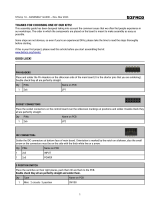CubuSynth Dual CS-20 VCF - Build Guide PCB V1.4 Mar 2023
Page 15
Step 20 – Calibration
The Calibration process contains the two trimmers for the 1V/octave scaling and an
Offset for the second Filters frequency to have them both on the same resonant
frequency.
V/O Trim1:
1. Turn the Resonance (Q) knob all the way clockwise
(100%) and both filter modes to LP
(counterclockwise / 0%)
2. Plug the Output (OUT1) from the Module to an
Oscilloscope or musical Tuner
3. Turn the Frequency down to 220hz (or a musical
note of your choice)
4. Apply 1V to the 1V/O input (one octave on a keyboard)
5. Trim the V/O Trim1 on the Back of the module until the frequency doubles
(440hz/ One octave above initial note)
6. Repeat steps 3-5 until the frequencies match –
V/O Trim2:
7. Plug a cable or a Jack connector to IN2 (to break connection from OUT1)
8. Repeat steps 2-6 for the Output “OUT2” and V/O Trim2
Offset 2:
9. Plug a cable or a Jack connector to IN2 (to break connection from OUT1)
10. Connect both Outputs to a mixer and mix them with same levels
11. Turn the Trimmer “Offset 2” until the frequencies of both outputs match.
Now turn the Frequency knob and assure that the frequency of both outputs stays the
same over the audible range.
If not, you will notice some “swinging” or phasing between them. Go back to adjust the
V/O Trimmers until they match.
This concludes the Trimming process and you can enjoy your module in perfect state.



























